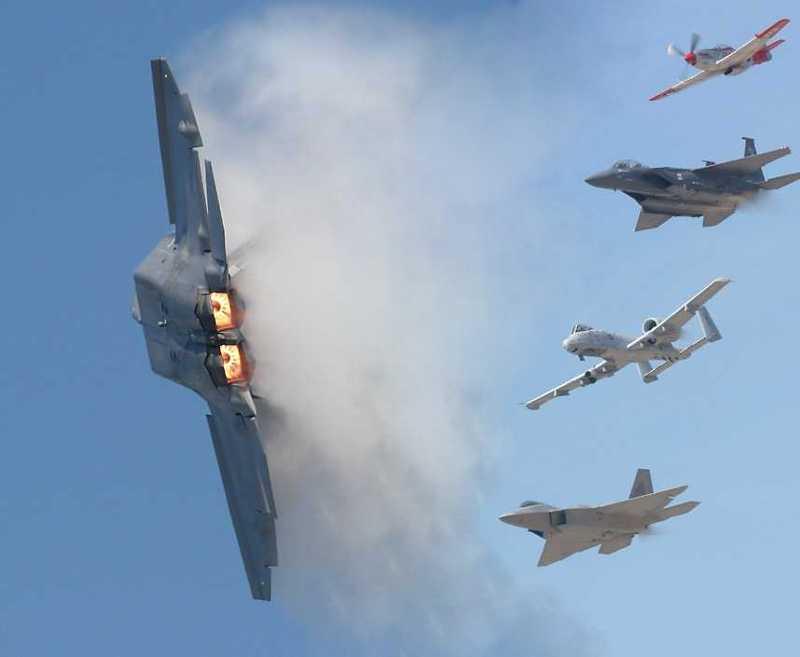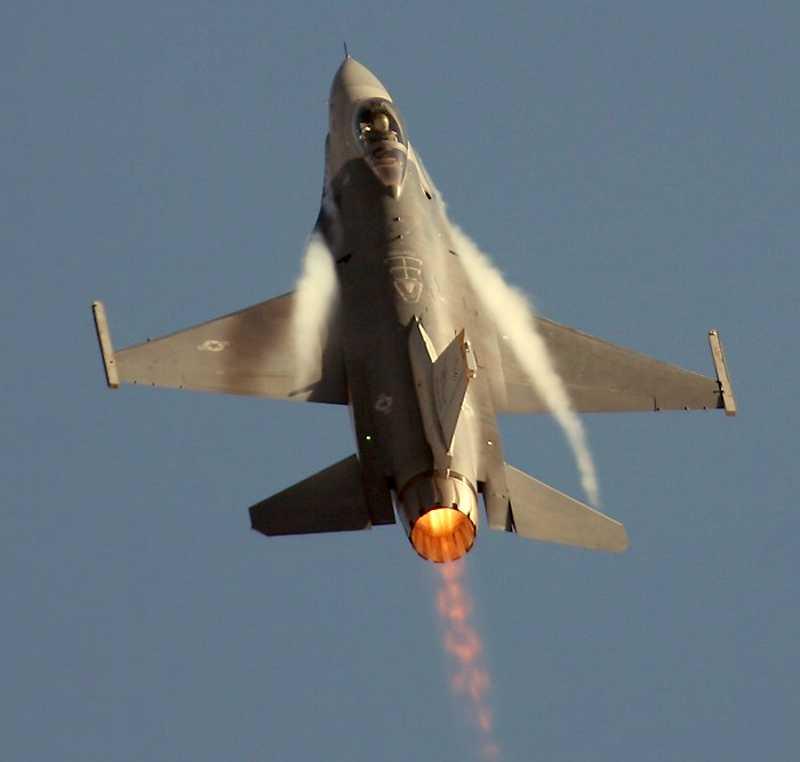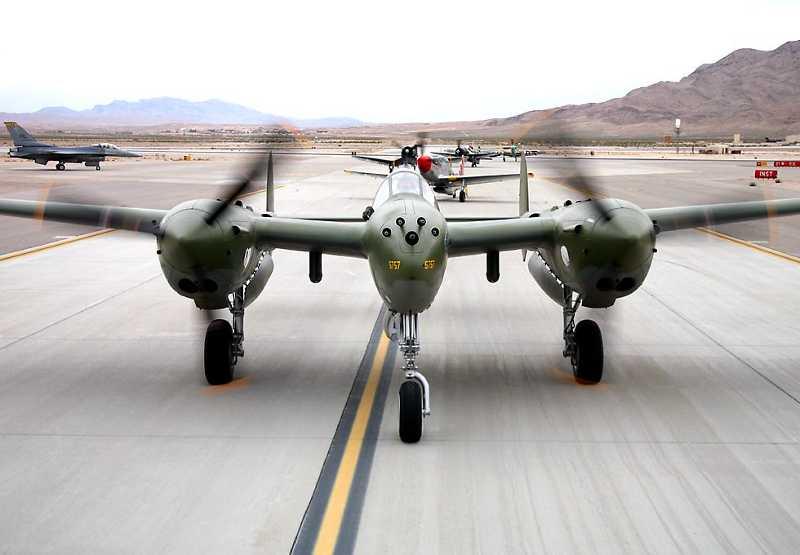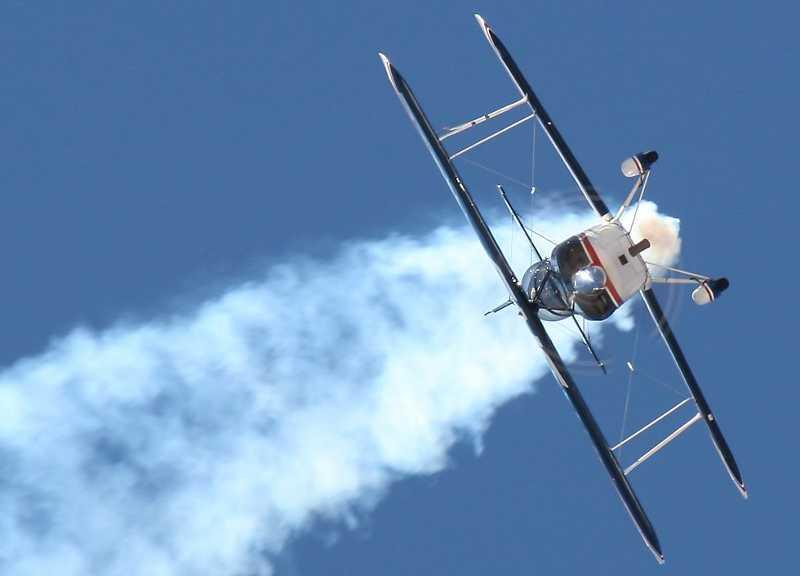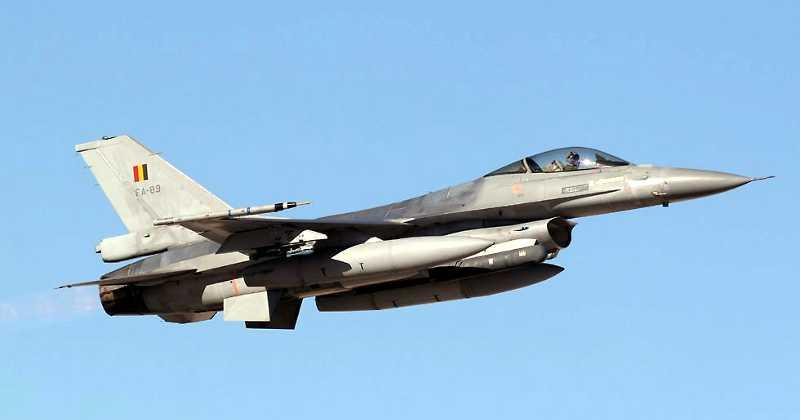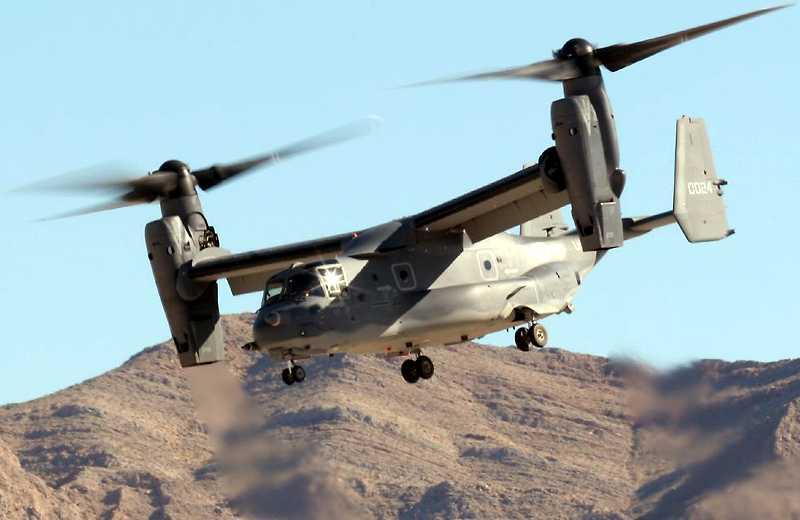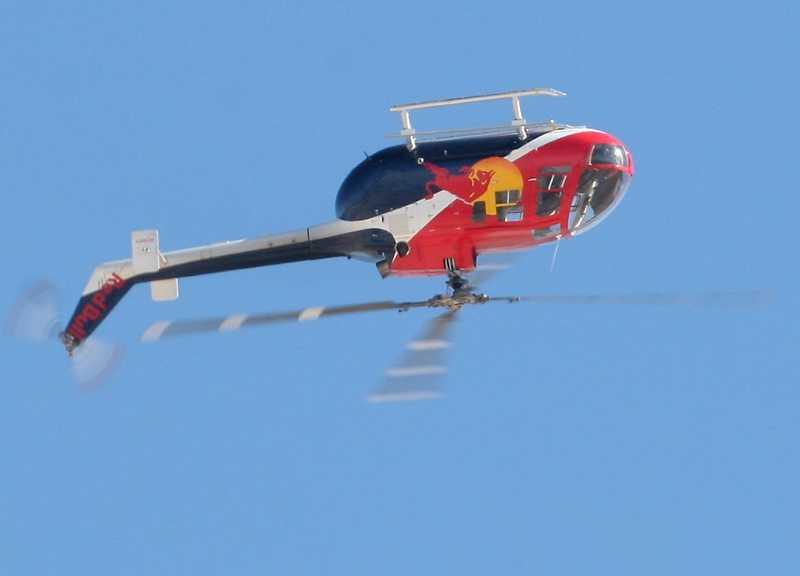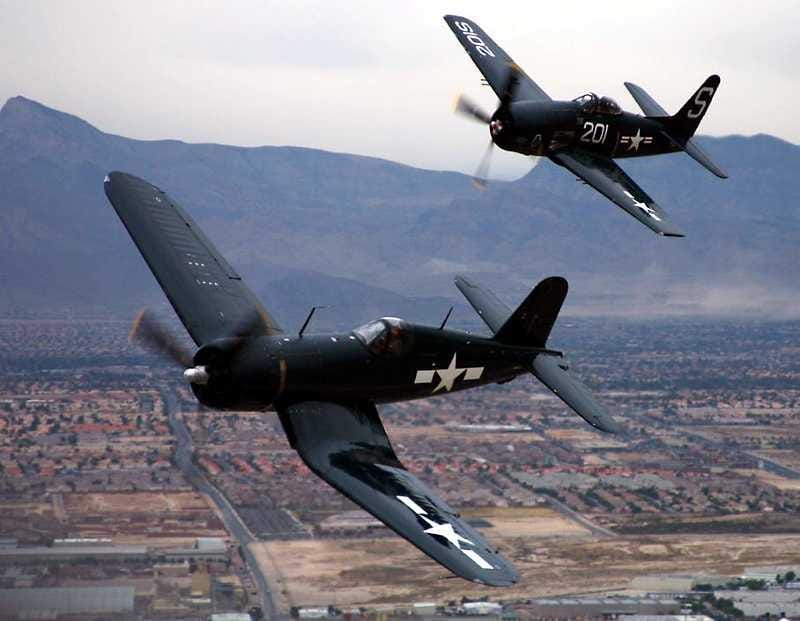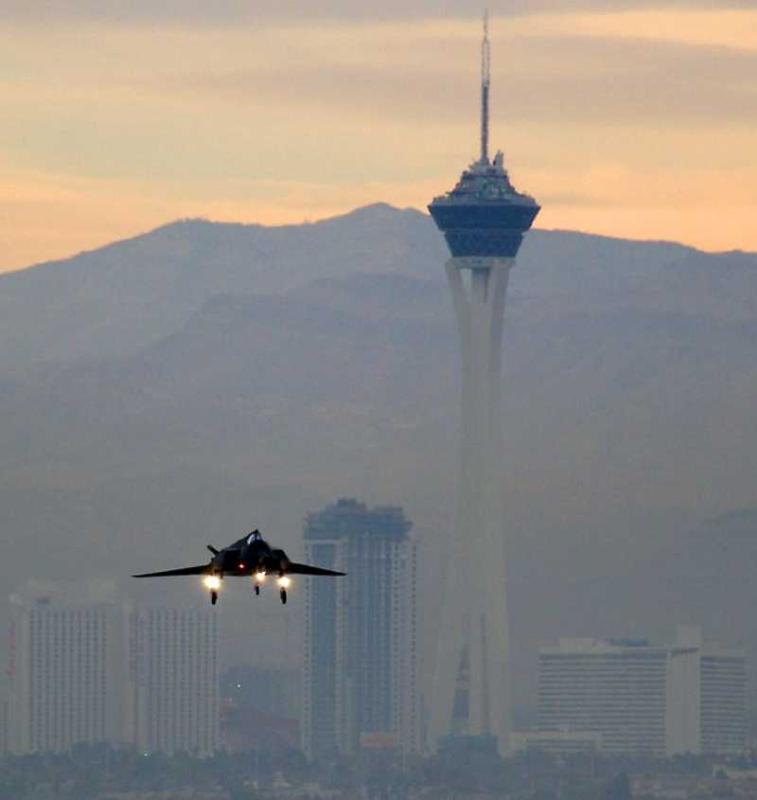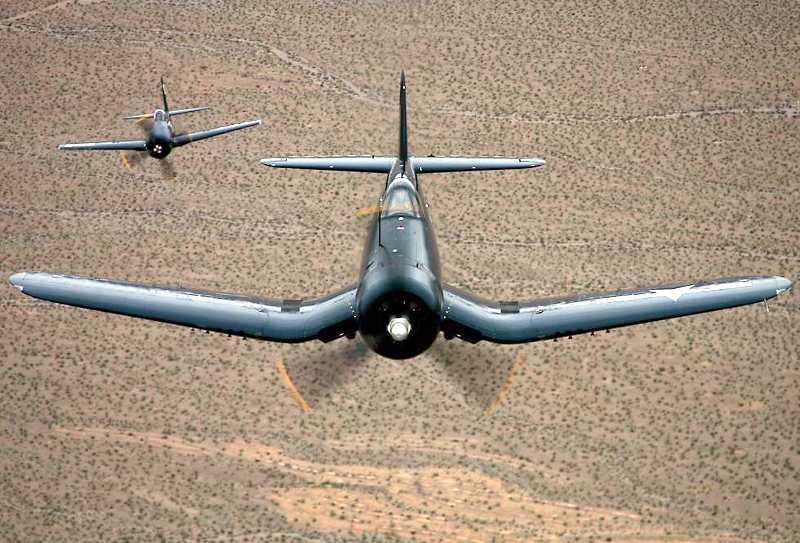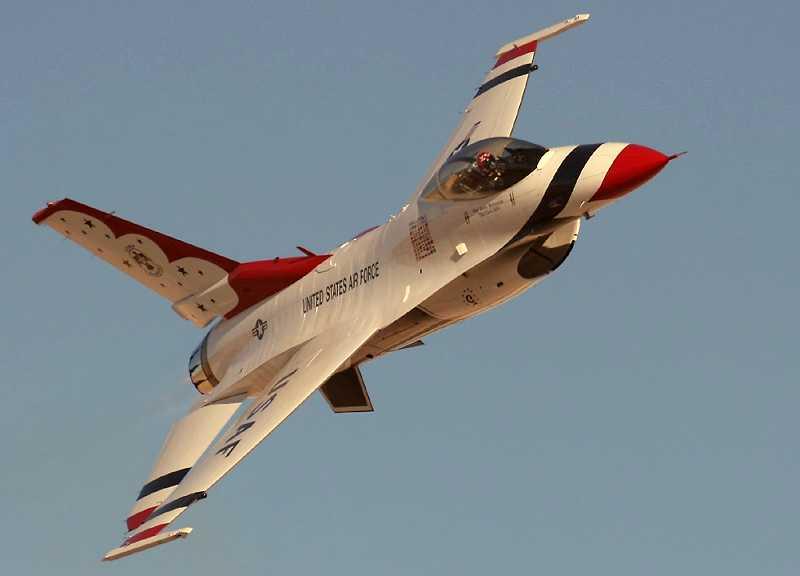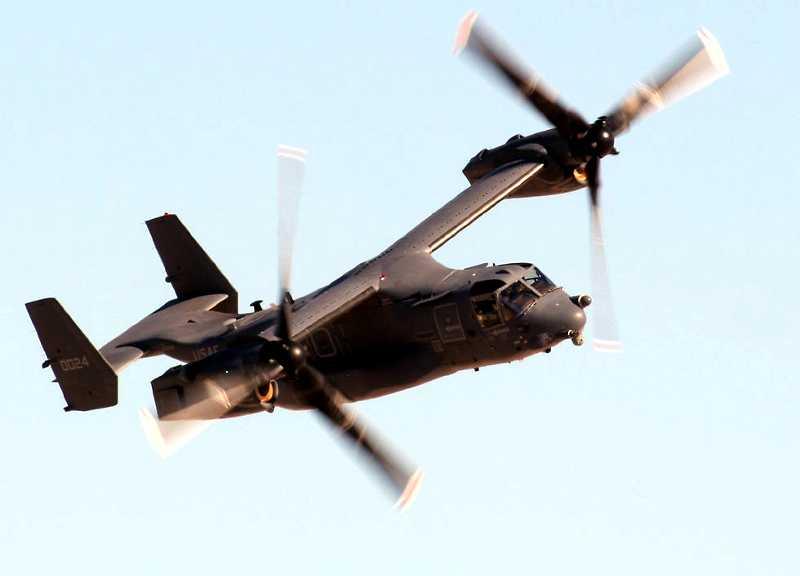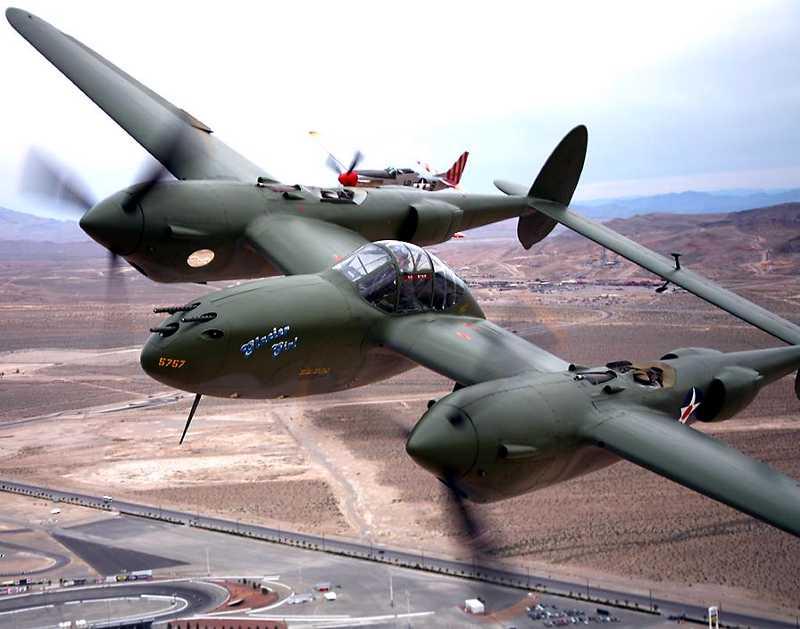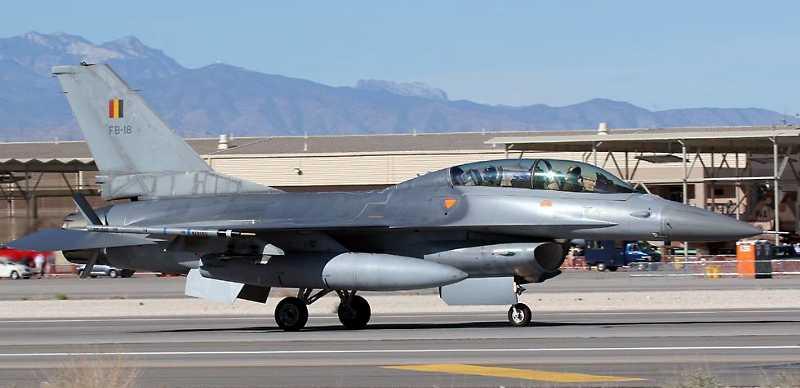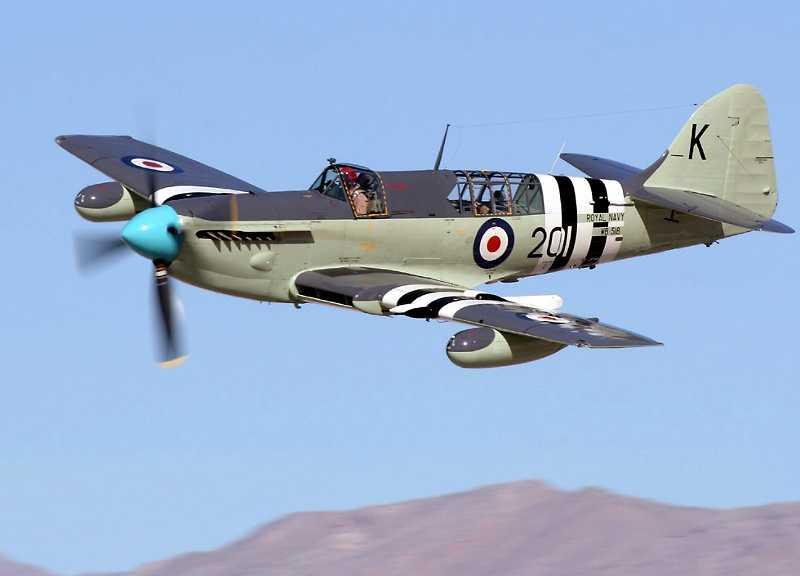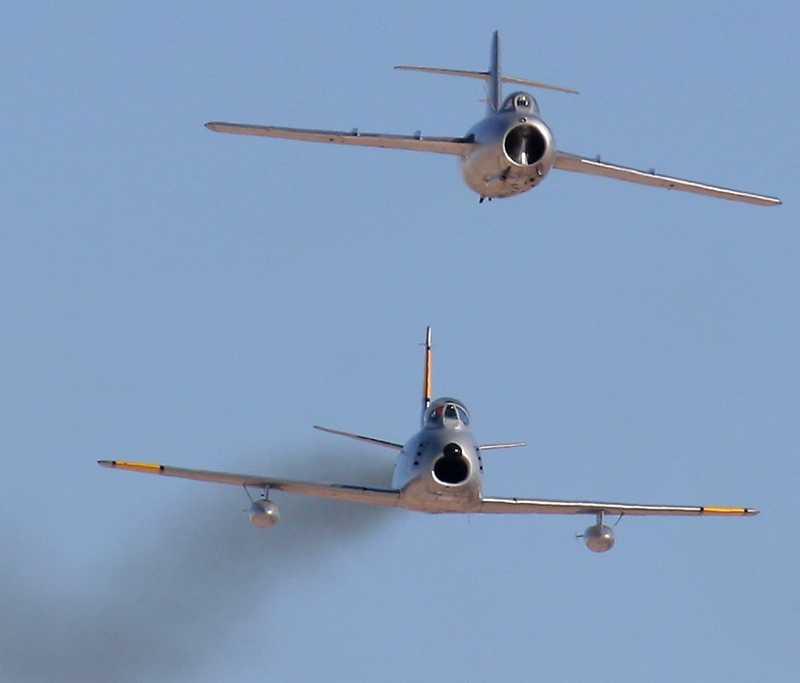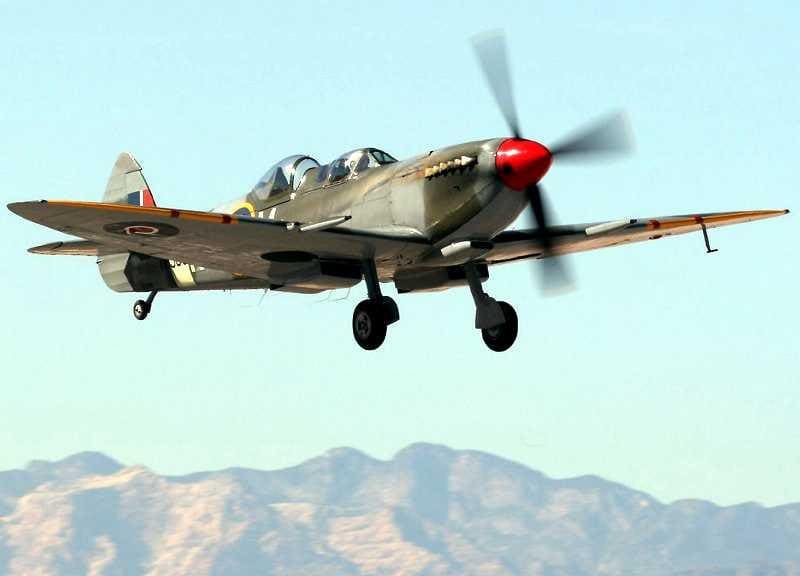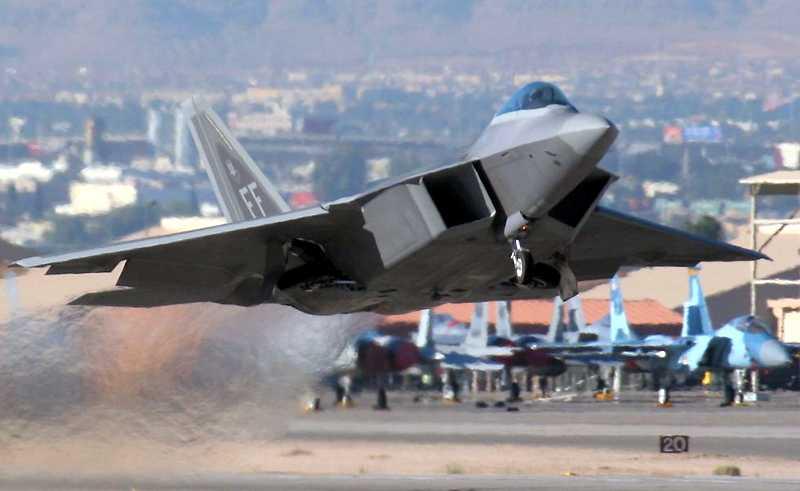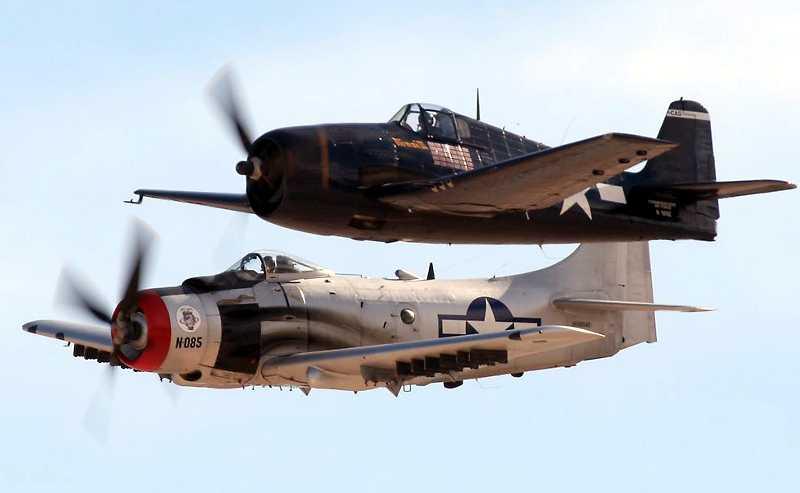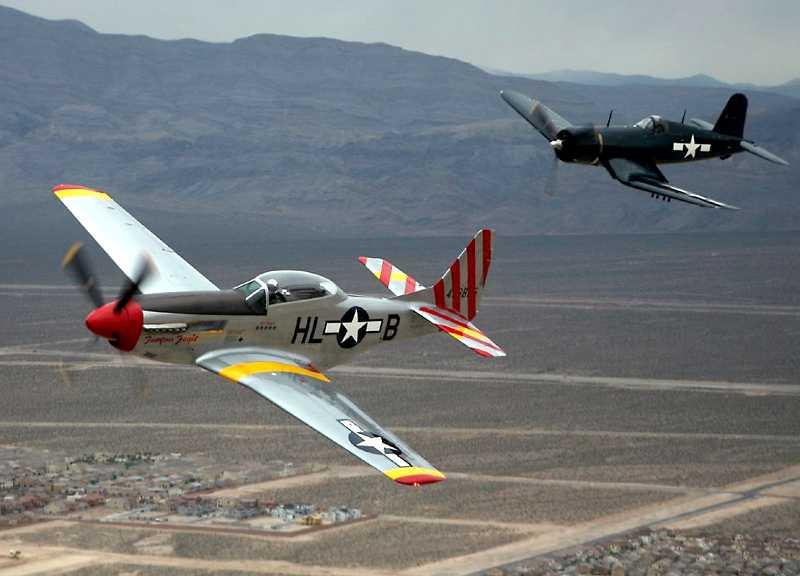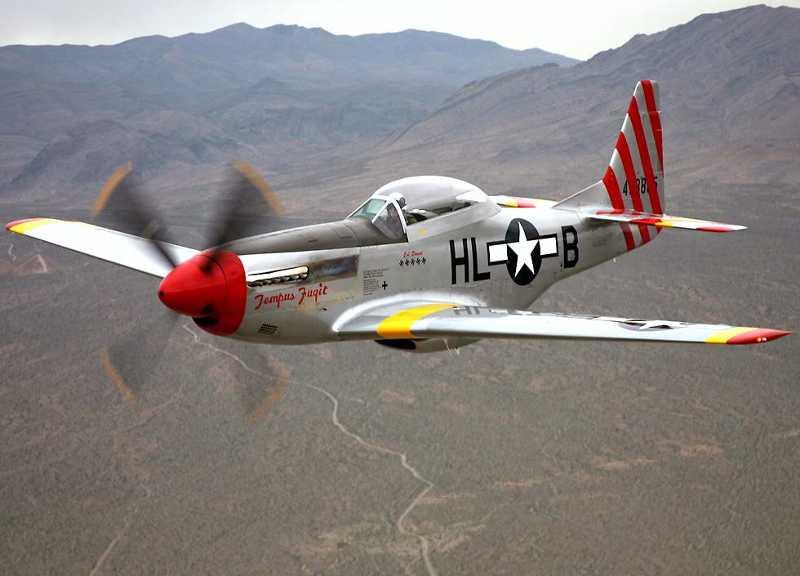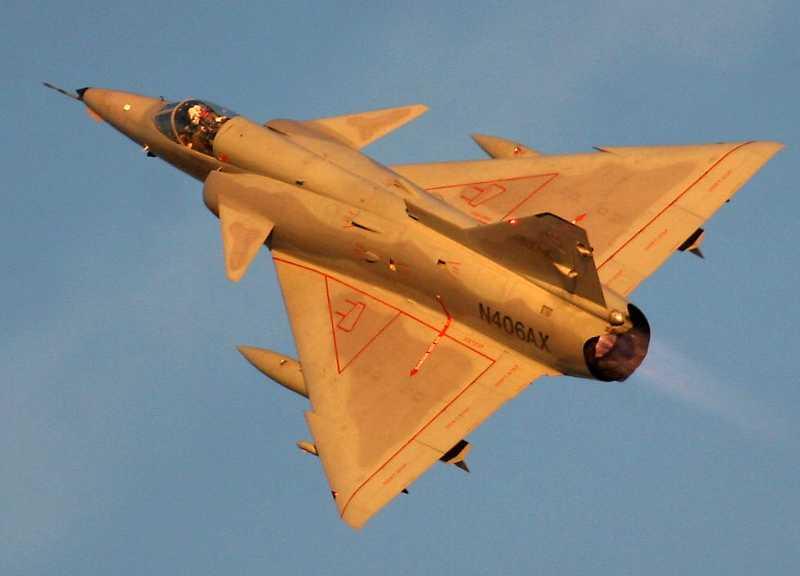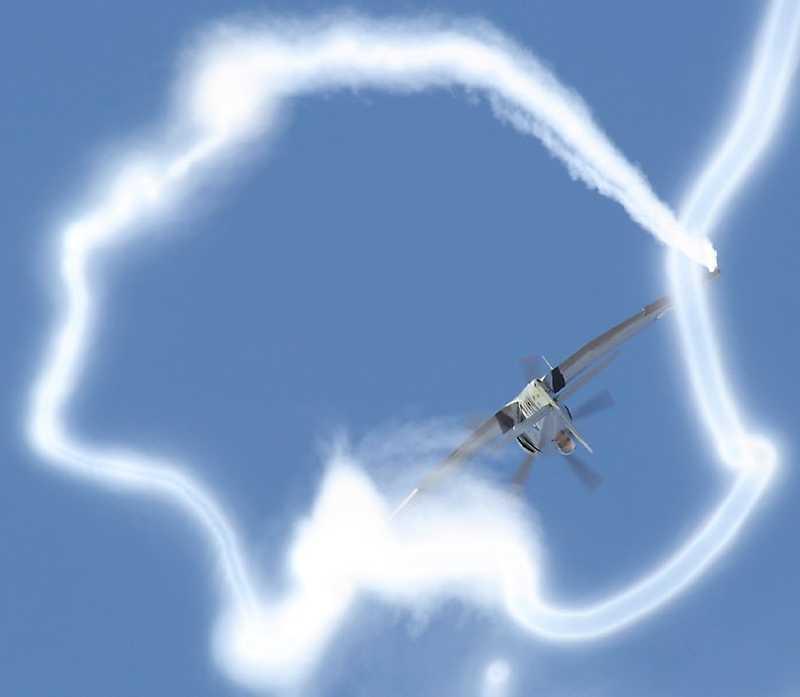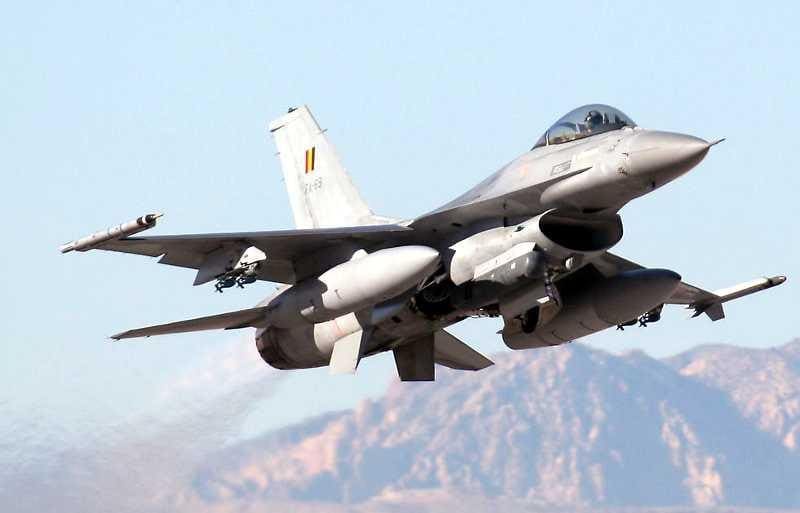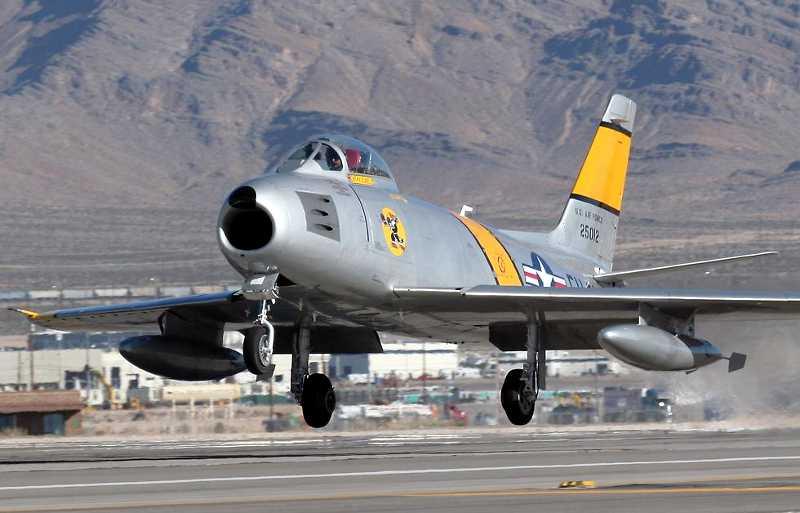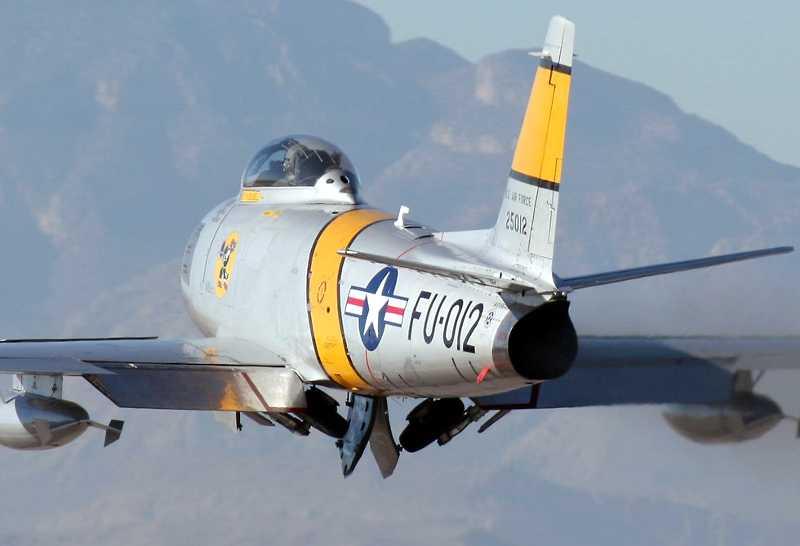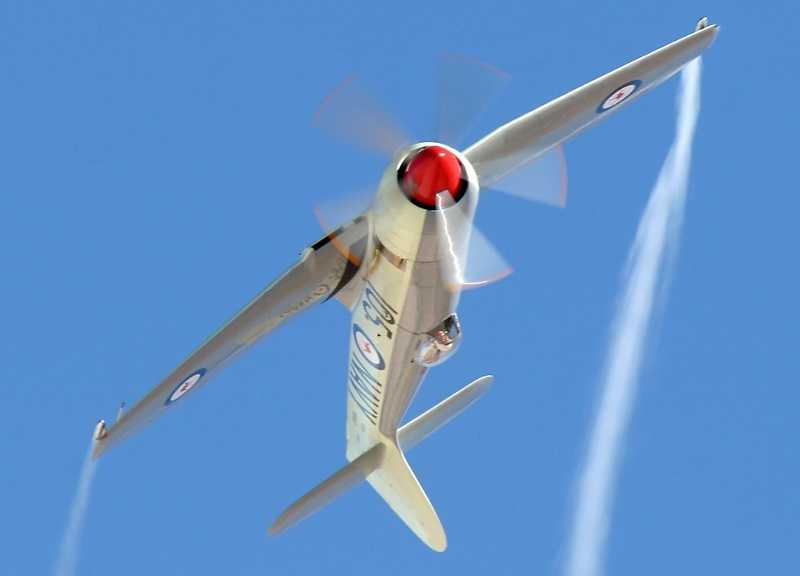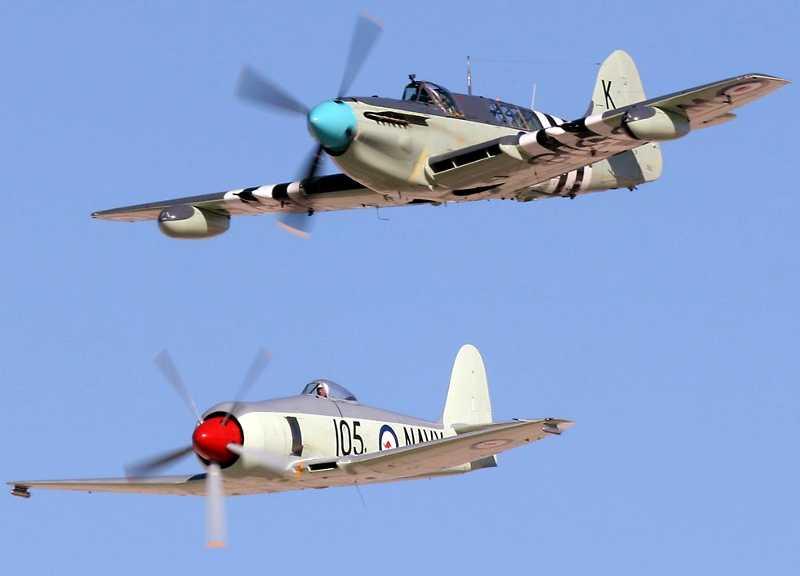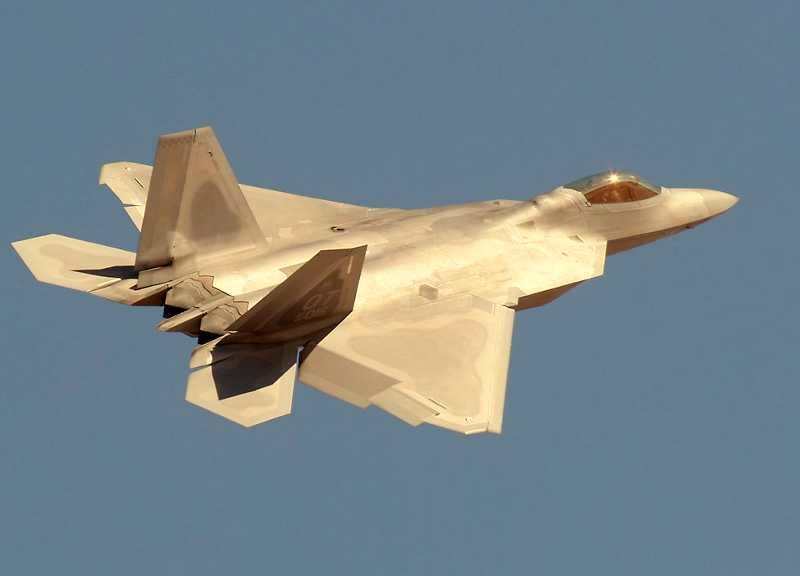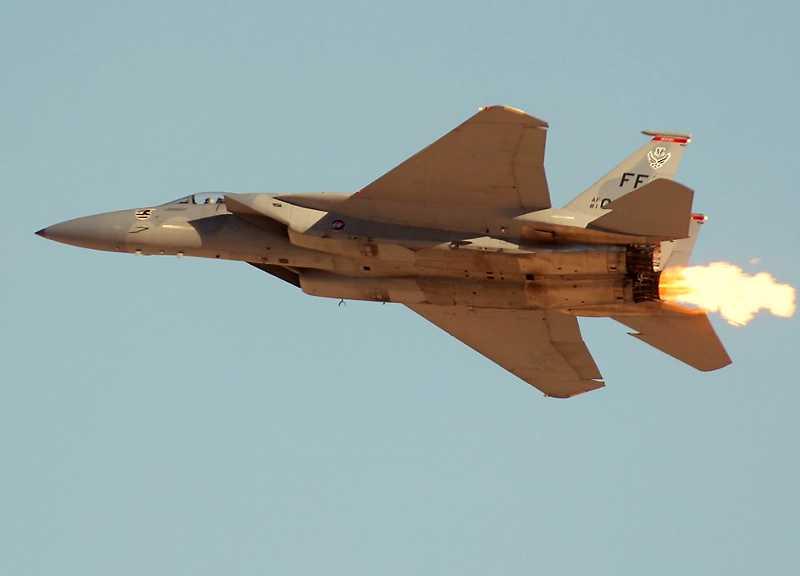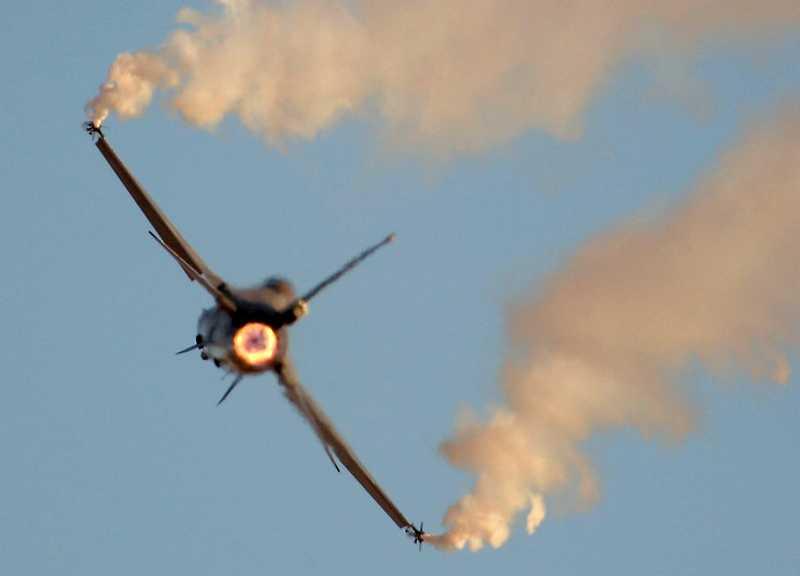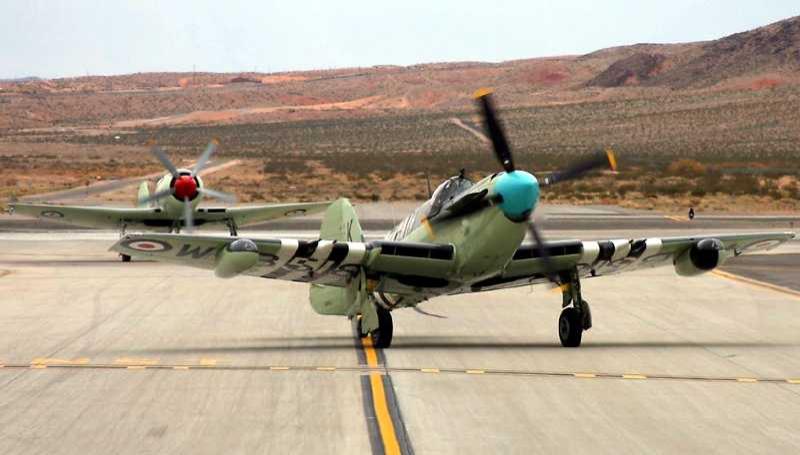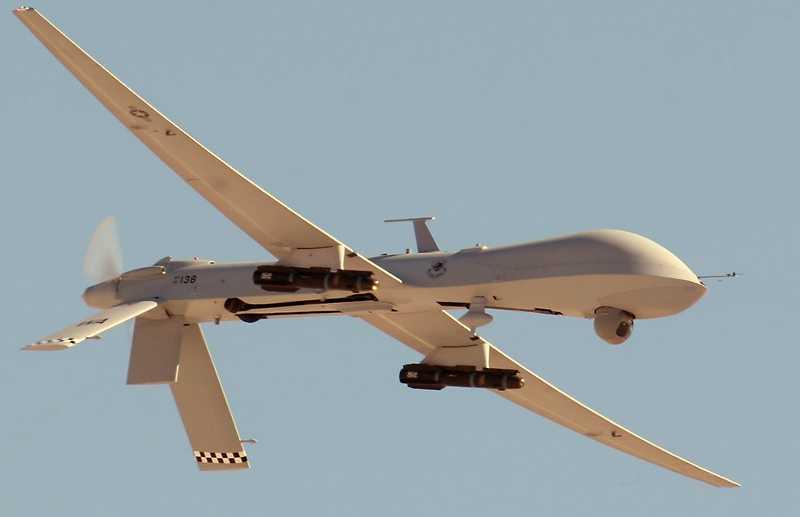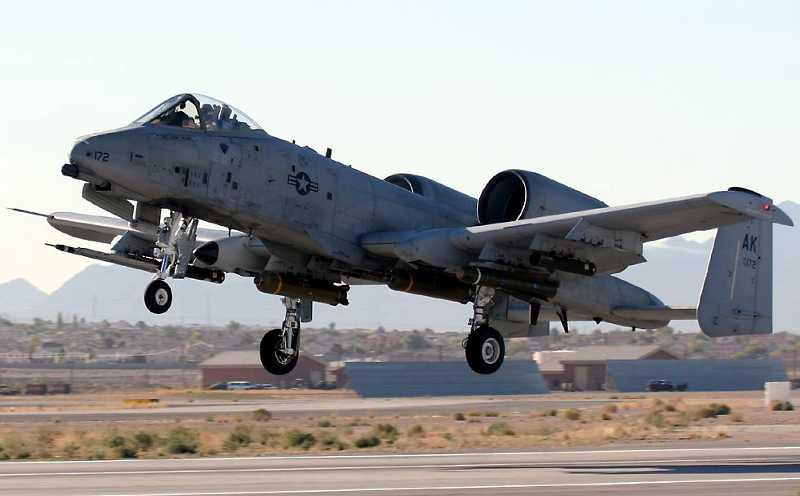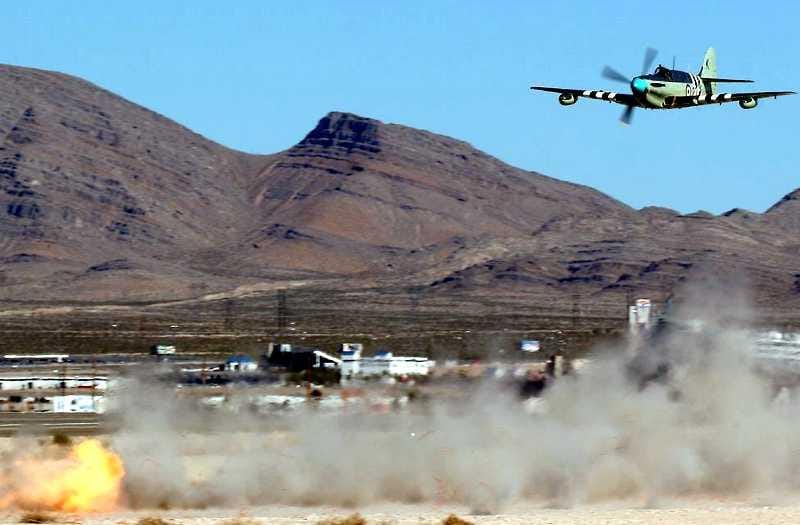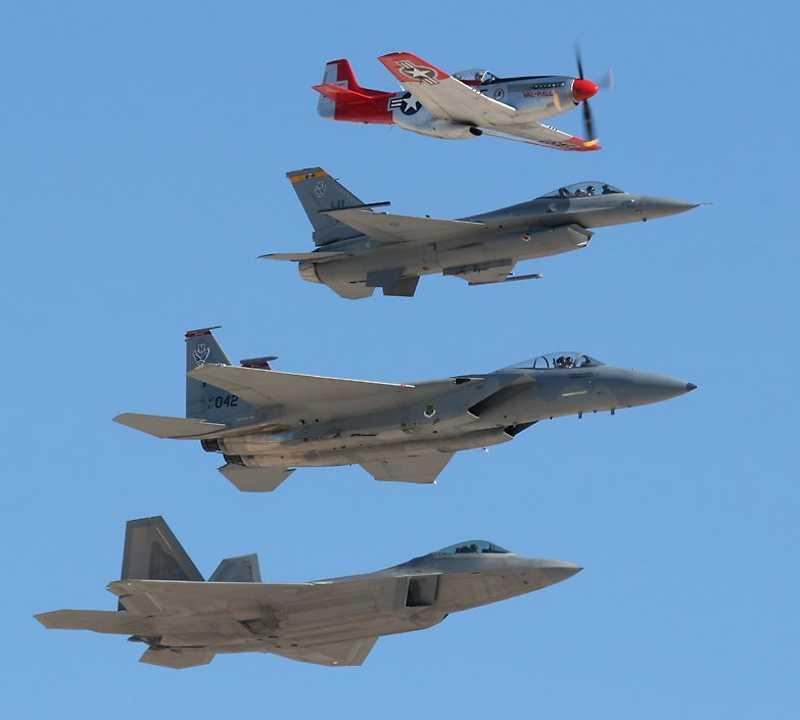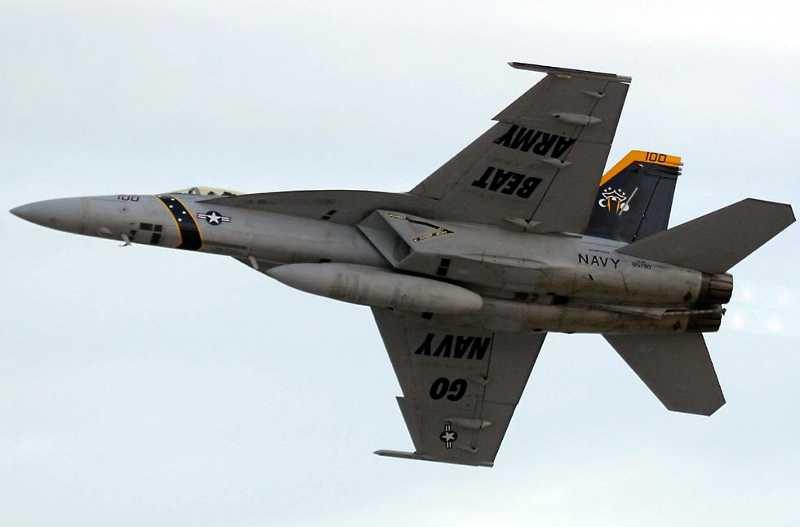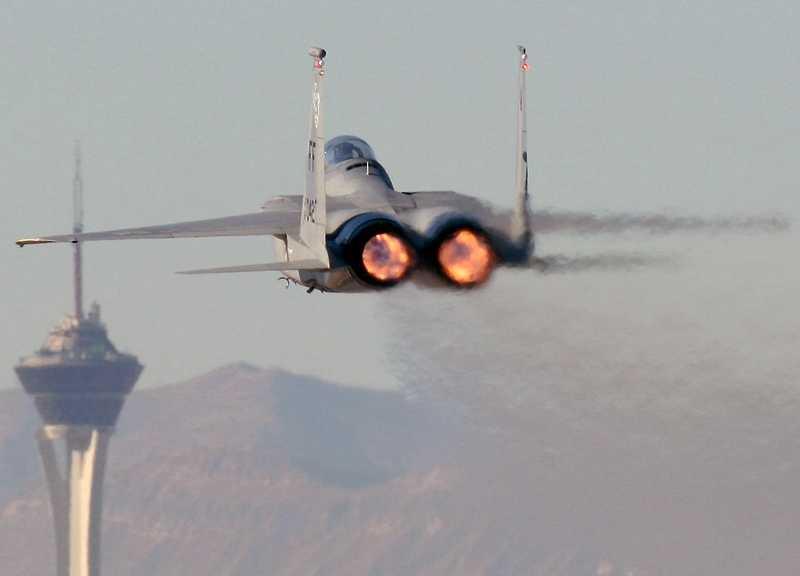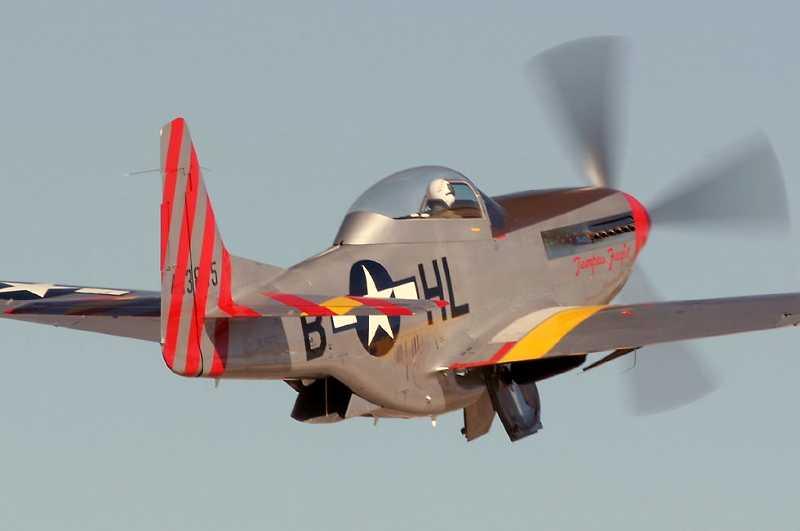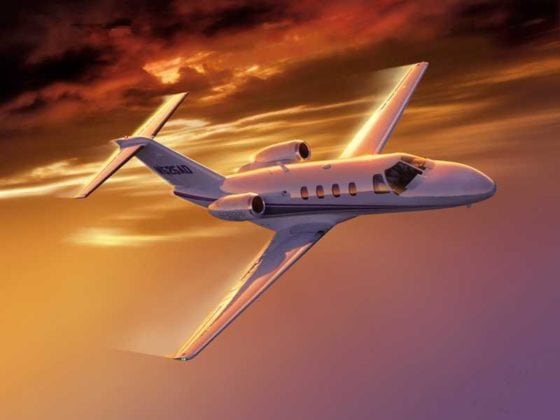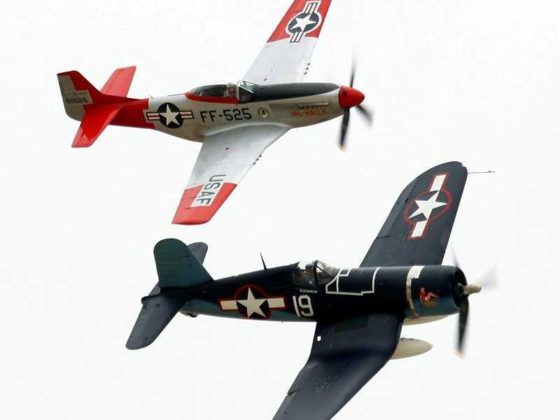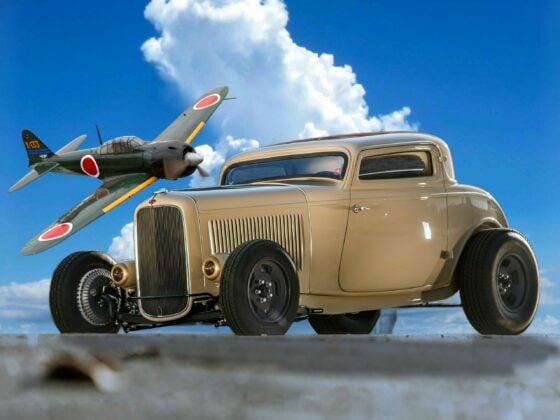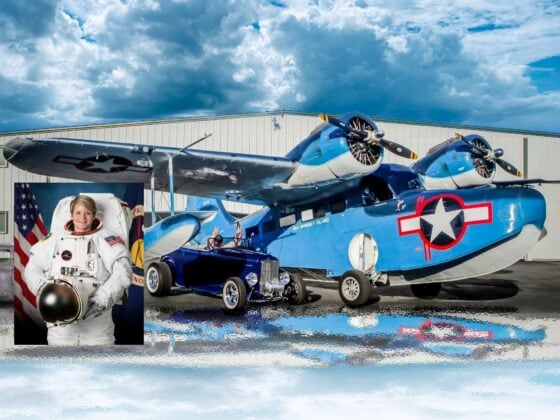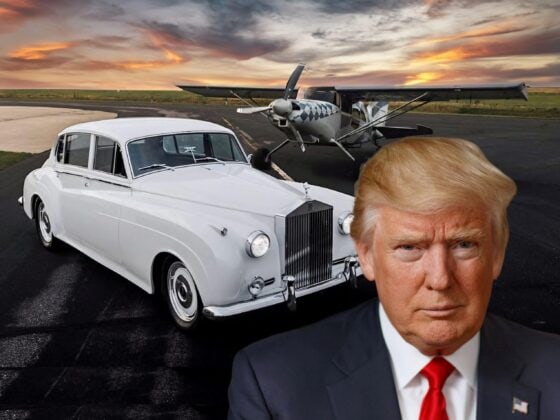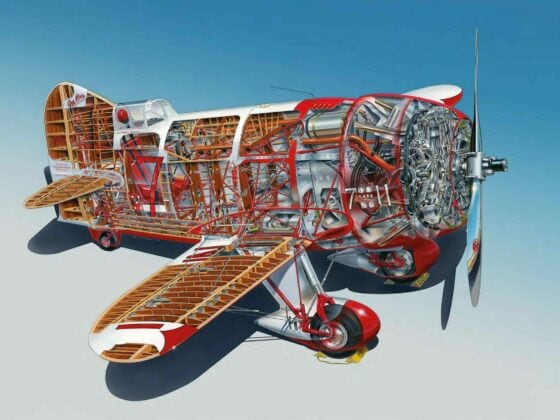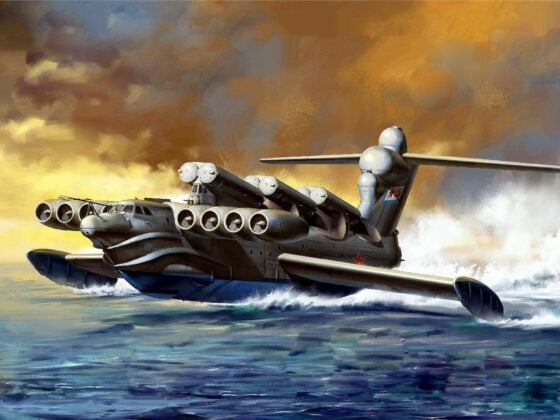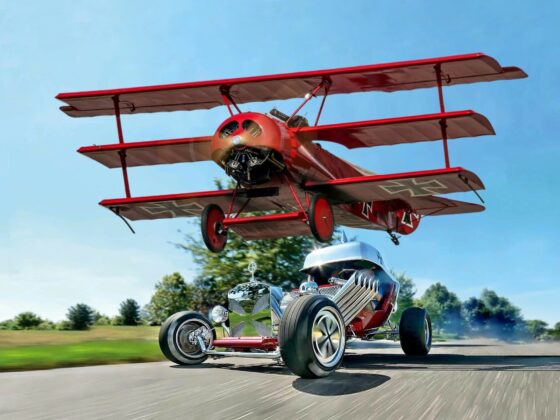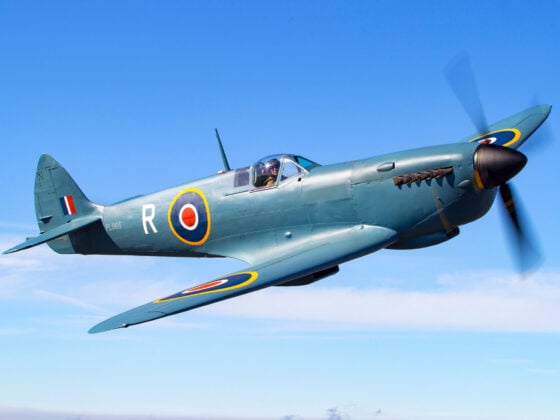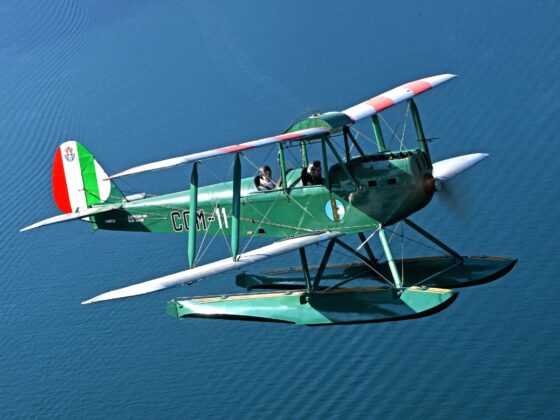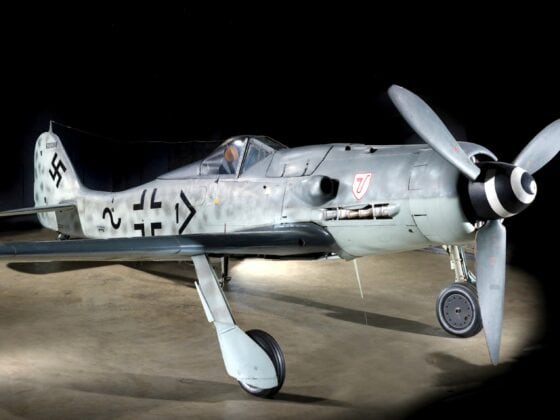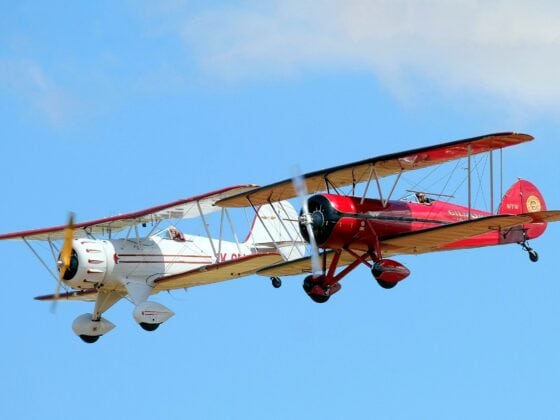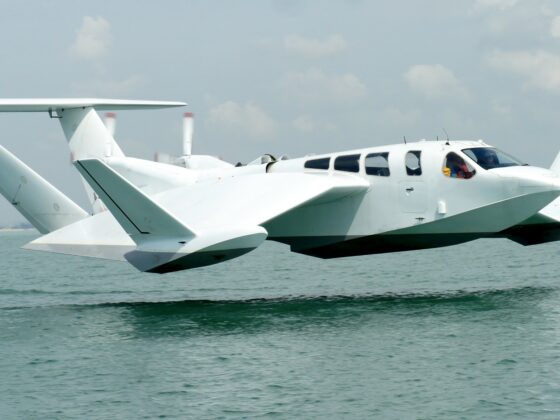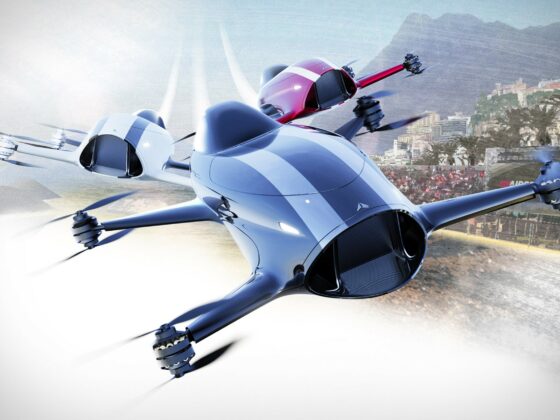Nellis “Aviation Nation” Airshow…
The usual excellent selection of world war two “warbirds” flew at the Aviation Nation airshow held at Nellis Air Force Base near Las Vegas.
The lineup was a bit thin on bombers with only the Air Classics B-25 Mitchell “Executive Sweet” present, but as this formation shows, there was a good mix of American air force and navy types, including two P-51D Mustangs, the P-38 Lightning “Glacier Girl” being flown by Steve Hinton, as well as an F4U Corsair and F8F Bearcat.
I wasn’t around for arrivals of static aircraft, so I missed out on seeing an EA-6 Prowler, E-2C Hawkeye and B-52 Stratofortress in flight, however I was around for a few of the departures such as the Kfir fighter, an Israeli variation of the French Mirage fighter, and on Friday’s media day there were flights by aircraft taking part in a Green Flag exercise, including armed A-10 Thunderbolt IIs, Belgian air force F-16 Fighting Falcons and a flight of F-22 Raptors.
On Saturday I also had an opportunity to take some air-to-air photos of some of the aircraft in the warbird formation you see here.
Although they’re both naval carrier aircraft, the Hellcat is a fighter which operated almost entirely during world war two, while the Skyraider is a ground attack aircraft which arrived just after the war, but had a long career including a great deal of service during the Vietnam war.
This formation was only part of the warbird contingent at the show, amongst the other American designed participants were this F6F Hellcat from Camarillo in California and an A-1 Skyraider.
Somehow I wasn’t able to get a decent photo of Glacier Girl, but here’s a view of the P-51D Mustang called “Tempus Fugit“, just after takeoff.
There was a lot of excitement in the aviation enthusiast community about this year’s show, since it was to include a “British Heritage” formation with five aircraft, the naval Firefly and Sea Fury fighters you see here, as well as a Spitfire, the classic Hawker Hunter jet and the brand new Eurofighter Typhoon performing its American airshow debut.
About two weeks out the Typhoon was scratched, purportedly for mechanical reasons, and although there was supposed to be a Tornado as replacement, this was also a no-show.
Since the Hunter also ended up being unable to attend, this meant the Firefly, Sea Fury and Spitfire were the only British aircraft which displayed.
For instance, Eddie Kurdziel’s Firefly is one of only two in the world in flyable condition.
However, that’s three more British aircraft than most American airshows had this year, and it was a rare opportunity, particularly considering the rarity of the three examples on display.
It’s a little known naval fighter which was operated by the UK, Canada and Australia.
It was the only modern purpose-built naval fighter of British design operated by the Royal Navy during the war and although it had a very powerful V-12 Griffon engine, it was nowhere near as fast as American fighters like the Hellcat and Corsair, largely due to the decision to carry a second crewman who acted as navigator.
However, testing at the American naval test center at Patuxent River showed that its maneuverability made it one of the few fighters able to successfully dogfight against the Hellcat.
After the war the Firefly was used as a naval anti-submarine, anti-shipping and ground attack aircraft in Korea and Malaya until retired in the mid 1950s.
The Firefly’s four 20mm cannons gave the Firefly a punch which most American aircraft lacked, and it operated effectively against German aircraft in Scandinavia and Japanese aircraft in the Far East, the first British aircraft to fly over Tokyo during the war was a Firefly.
Here you can see it during a simulated strafing run set up by Chris Rainey and his merry band of pyrotechnic pranksters.
The Sea Fury isn’t very well known in the United States as a military aircraft, but because of its very high performance about ten of them have been used as racers.
The Sea Fury wasn’t about to miss out on the pyrotechnic mayhem, either !
However, the same speed that makes it a good racer also allowed it to operate as an effective fighter, in 1952 a Sea Fury serving in Korea became the first piston-engined aircraft to shoot down a MiG-15 jet fighter.
However the performance generated by its 18 cylinder Centaurus radial engine made it an international success, with exports to Canada, Australia, the Netherlands, Egypt, Iraq, Burma and Cuba.
Although this aircraft was also being developed in an air force version, the war ended before they were operational and so only the naval version went into production.
The Cuban Sea Furies were used against the CIA sponsored anti-communist fighters during the Bay of Pigs battle.
Ellsworth Getchell operates this one in Australian navy colours, though he’s added some definitely non-regulation smoke generators to make it stand out during the aerobatic demonstrations he does during lulls in the warbird display.
The ugly duckling of the British Heritage display was this two-seat TR.9 Spitfire.
There are many two-seat warbird fighters on the airshow circuit, especially Mustangs, however most of these are modern conversions to allow a passenger to be taken aloft.
This Spitfire was built as a single-seat Mk IX fighter in 1945, but was converted after the war to a two-seat TR.9 trainer and used by the Irish Air Corps.
Here you can see it taking off at the start of the demonstration, which took place at the same time as the world war two aircraft displayed; the older aircraft did simulated pyrotechnic ground strikes, and as they went around for another wide circuit, the Korean era aircraft would do their display, keeping crowd interest high.
Another theme of the show was the Korean War airpower demonstration, featuring the F-86 Sabre operated by the Planes of Fame museum at Chino.
Although its armament of six 50 caliber machine guns is somewhat lightweight, its performance and excellent handling ensured that it would be the first really successful American jet fighter.
Steve Hinton, says that the Sabre is his favorite aircraft of all of the different types that he gets to fly.
Although it had better armament and nearly the same performance as the F-86, the MiG-15 was at the wrong end of a roughly 10 to 1 kill ratio, due largely to superior training of the American pilots.
The Korean airpower demonstration consisted of the Sabre doing tail chases against its old foe, the Russian designed MiG-15 “Fagot” which came as a nasty shock when it first entered combat in Korea.
The ever popular Sean Tucker flew his custom built Oracle Challenge in a wide variety of difficult maneuvers, both with and without smoke.
Several aerobatic aircraft strutted their stuff and provided some balance to the military equipment on display.
Craig Teft was the other aerobatic performer, showing off the various stomach churning moves he can do in his Pitts Special.
The helicopter is sponsored by the Red Bull energy drink, which supports quite a few aircraft around the world, including Bill Reeseman’s MiG-17 “Fresco” which flew at Aviation Nation, as well as a Grumman Albatross seaplane which was on static display.
There was a highly unusual aerobatic act at the show, a German designed Bo-105 helicopter, which because of its solid rotor hub system can perform some very unhelicopter-like moves such as barrel rolls and full loops !
A different three generation Heritage Flight was flown in the morning with a P-51, F-86, F-15 and F-16, which means that it would have been theoretically possible to have had a formation with four generations of fighter, if the P-51, F-86, F-15 and F-22 had been flown together.
The modern military displays were started off with an air force “Heritage Flight” with three generations of American fighters in formation.
The F-86, F-15 and F-16 did fly together, but again if the F-22 had been substituted for the F-16 then it would have been a formation with three generations of jet fighters.
There were quite possibly excellent technical or logistical reasons why these other formations weren’t flown.
The navy also had the opportunity to do a “Legacy Flight” with the F6F Hellcat, A-1 Skyraider, Sea Fury and F-18F Super Hornet, an unusual mixture of fighters with a ground attack plane, as well as American and British designed aircraft flying together!
Several Belgian F-16s were at Nellis for a Green Flag exercise, but in America it’s an extremely rare event to have a demonstration by a foreign aircraft.
The show organizers were unable to get a Typhoon or Tornado, but they did pull off a coup with a different foreign aircraft, this Belgian air force F-16 Fighting Falcon.
As far as I know, the Belgians only did one other display in America, at the Edwards AFB show.
As well as using smoke generators and on some occasions flares, the Belgians and Dutch both do a very high power routine with lots of afterburner, all while staying close in to the crowd.
The Belgian and Dutch F-16 displays are widely regarded as the best in the world.
With a USAF F-16 demo at the same show, it was easy to compare the styles, with the American aircraft relying more on loud and fast passes in front of the crowd, which results in gaps in the display as the plane comes back to the crowdline.
It’s still an exciting display, but not quite as crowd pleasing as the Europeans.
This was the last demonstration by the Viper West display pilot “Mojo“, next year his replacement “Spicoli” takes over.
Talking about loud and fast, here’s the F-15 Eagle demonstration ship hurtling off in the direction of the Las Vegas strip.
On Friday’s media day there was an unintended addition to the routine when the F-15’s starboard engine experienced a burner blowout while doing a low altitude pass along the crowd line.
It was the first time I’ve seen this at a show, but there was little risk of an incident since the engine was still producing power during the extremely brief event.
This is the world’s first true stealth fighter, and it sports other advanced technology like thrust vectoring nozzles which provide it with unprecedented maneuverability for an American aircraft.
For many years the F-15 was America’s premier fighter, but that position now belongs to this aircraft, the F-22 Raptor.
Indeed during the F-15 display many in the crowd weren’t watching, instead looking backwards at the F-22 high up and far off in the distance as it performed feats previously only achieved by Russian aircraft such as late models of the MiG-29 “Fulcrum” and Su-27 “Flanker“, displaying at shows like the biannual MAKS airshow near Moscow.
Unfortunately it’s still too early to know whether American audiences will ever have an opportunity to see maneuvers like the “cobra“, since the American military has become increasingly reluctant to do dramatic maneuvers in their aircraft.
The first operational stealth aircraft, the Nighthawk is theoretically capable of carrying air-to-air missiles and thus justifying its fighter designation; however, it’s actually a ground attack aircraft, that’s all its pilots train for, and the fighter designation is much more likely to have been a deliberate deception to cause confusion about an aircraft which was a classified secret for the first five years of its operational service.
This is just the beginning of the F-22’s career, but it’s sunset for another aircraft which carried the “stealth fighter” moniker, the F-117 Nighthawk.
The F-117 is already on the verge of retirement, even though most people can hardly believe that it’s been around for 25 years. It’s a very expensive aircraft to operate, the fleet of 45 or 50 aircraft based at Holloman AFB in New Mexico cost about a quarter of the entire British military budget.
The F-22 has ground to air capability, so the intention is to use the Raptor in place of the Nighthawk in situations where low observability is needed.
The CV-22 is the air force version of the Osprey, it has aerial refuelling and more radar capability than the marine corps’ MV-22. This was one of the first outings for the CV-22.
The F-22 wasn’t the only new face in the American military which was present at the show, there was also a very complete display by a CV-22 Osprey.
I saw an MV-22 at the 2006 Miramar airshow but the weather was horrible, and I devoted a day and several hundred miles of driving to seeing the CV-22 at the Edwards AFB media day, only to have it not fly.
Although it has had a drawn-out and chequered development history, its capabilities make it much more useful than the Vietnam era helicopters that it will replace.
The Osprey is an impressive aircraft.
It’s able to carry twice the load at twice the speed to twice the distance, and it does all of this much more quietly than a regular helicopter.
There are definitely downwash problems when doing crew pickup during search and rescue missions and it’s also problematic to fit it with defensive guns, but overall it’s likely to be a big asset.
With so many aircraft like the F-117, F-14 and other types retiring, and only a few new manned aircraft like the F-22, V-22 and F-35 in the pipeline, it seems that unmanned aerial combat vehicles like this MQ-1 Predator might be the way of the future.
Is this the shape of airshows to come ?
Armed as you can see with hellfire missiles, the Predator is used for reconnaisance and ground attack, but in the future it might be that aircraft such as this one will take over the role of air-to-air fighter, since the limiting factor in maneuverability for many modern aircraft is the human pilot, who can only handle so many Gs of force.
There has already been at least one air-to-air engagement between a Predator and an enemy fighter, in 2002 a Predator fired an air-to-air missile at an Iraqi MiG-25.
The missile missed the MiG, but a missile from the MiG destroyed the Predator.
As always the last display at any Aviation Nation airshow is the homecoming performance of the USAF “Thunderbirds” display team flying their carefully choreographed routines for the final time of the year.
Green Flag is a less well-known counterpart of the Red Flag exercises, designed to teach electronic warfare skills rather than the air-to-air combat and bombing training of Red Flag.
Green Flag includes training on the locating and destroying of radar sites and mobile missile launchers like the Scuds used by the Iraqis.
The great thing about watching one of these exercises rather than a regular airshow is that the aircraft will be carrying ordnance, some dummy and some live, as well as electronic detection and countermeasure equipment like the unit you can see at the far end of this A-10’s starboard wing.
In the background you can see just a few of the Nellis-based F-15 Eagles which are painted up in “aggressor” colors.
It was an impressive sight to see a flight of four F-22 Raptors head out to the ranges, including this fellow who didn’t waste any time pulling up his undercarriage after takeoff.
These serve as attackers or defenders during the Red Flag exercises.
It’s very special to see a whole group of the air force’s most recently acquired fighters going out on exercise together. Raptors haven’t been included in Red Flag up to now because it’s hard to know how to integrate them. If they’re as effective as claimed then they’ll be able to clear all hostile aircraft out of the sky in very short order, which doesn’t help those aircrew much with their training.
There’s little question that the Raptor has taken over the mantle of the Eagle as the world’s premier air-to-air fighter, but it’s an open question whether it will ever capture the public’s imagination in the way that the Spitfire, the Mustang, the Starfighter or the Phantom did.
The Raptor’s shape certainly owes more to function than to aesthetics, and its lethality is mostly hidden, too, since its missiles and other ordnance will usually be kept in internal bays in order to preserve the plane’s stealthy characteristics.
As you can see, these Raptors are operating with their navigation lights functioning, which they certainly wouldn’t be doing in a war-time situation or even when they’re on the Red Flag and Green Flag test ranges; however it’s a necessity when they’re flying in the airspace around Nellis, since it’s so close to the flightpaths of all of the civilian aircraft entering and leaving the Las Vegas area.
The small unit visible under the belly of this Raptor is also present only to make the aircraft visible to air traffic control systems.
Here’s one of them taking off with a Las Vegas icon, the Stratosphere Tower, in the background.
Friday’s Green Flag session also had foreign participants in the form of a squadron of Belgian air force F-16 Fighting Falcons.
Las Vegas is of course a considerable temptation for both the American and foreign aircrews, so apparently special emphasis is given to safety considerations on Mondays !
The hope is that this level of realism will make pilots more likely to survive when they do end up in aerial combat, or in a high-threat missile situation.
Both Red Flag and Green Flag are designed to be about as realistic as training gets, which means that accidents are inevitable.
Looks like this Falcon has a missile on the port wingtip, an electronic sensor on the right wingtip, an ECM unit under the intake and 25 pound BDU-33 practice bombs on the wing racks, which fall with the same trajectory as the much larger 500 pound MK82 bomb.
The GIB “guy in back” of this Belgian two-seater takes the time to wave to me, quite a common occurrence when a long lens is being pointed at an aircraft.
Moving from the new to the old, here are some photos of the warbird formation which displayed during the Saturday show, taken from the tail gunner’s position at the back of the B-25 Mitchell bomber “Executive Sweet“.
And what could be nicer than this F4U Corsair approaching the formation ?
Well, how about an F4U and an F8F Bearcat ? They’re both naval fighters, but the Corsair was manufactured by Chance-Vought and the Bearcat by Grumman, the most successful builder ever of naval aircraft.
The Corsair itself was phenomenally successful, it had a rocky start but after the British found a way to tame its tricky carrier landing characteristics it soon found its place both as a fighter and doing ground attack work.
Surprisingly, the Corsair remained in production for quite some time after manufacture of the Bearcat ended, largely because of its effectiveness as a stable platform for combat air support.
The Bearcat just missed out on service during world war two, but both aircraft were used during the Indo-Chinese conflict which started after the world war.
The Mustang was even more successful than the Corsair, it served with the air forces of far more countries and stayed in service much longer.
This Mustang, “Tempus Fugit” is owned by Tony Raftis, it served as a P-51D with the Royal Swedish Air Force before being sold to the Nicaraguan air force.
Its restoration as a TF-51 two-seat trainer was only completed in 2006, being painted in this scheme only three months before Aviation Nation.
There are many Mustangs on the airshow circuit, but very few P-38 Lightnings, so it was a real pleasure to have Steve Hinton flying this one, called “Glacier Girl” in memory of its retrieval and restoration from underneath many feet of Greenland ice.
Steve gets to fly many different types of classic aircraft as the head man at the Fighter Rebuilders facility at Chino in California, and he’s not afraid of bringing his ship in close with a formation, whether it’s a group of warbirds like this one, or one of the air force’s Heritage Displays, which sees him flying a classic alongside a modern craft like the Eagle or the Raptor.
Back on the ground again, with Eddie Kurdziel’s Firefly and Ellsworth Getchell’s Sea Fury, two British naval fighters;
Viper West display pilot “Mojo” waits to take his F-16 out for its demonstration while the warbirds taxi back in.
The B-25 bounces around a surprising amount while taxying, so it required a real mixture of skill and luck to come away with a sharp photo of the planes coming back down the taxiway.
For real diehard aviation enthusiasts, the airshow isn’t even over when it’s over.
The end of the show often means the start of the departures, and sometimes it’s the only opportunity to see aircraft in the air which are only ever on static display, like the Grumman Albatross seaplane.
On a slightly different note, this F-18E Super Hornet took off and then did another pass for the benefit of the large group of photographers still assembled in the spectator area.
The pilot made sure to make clear his allegiances in the ongoing inter-service football rivalry !
Even better was the departure of this Kfir fighter, now owned and operated by a civilian outfit called ATAC, which provides dissimilar-type training on contract for the military.
This involves flying modern American aircraft against foreign aircraft in order to give pilots the sense of flying against unfamiliar planes which perform differently than American-designed craft.
The Kfir “lion cub” is an Israeli modified version of the classic French Dassault Mirage 5 fighter.
It was fitted with a larger engine than the original, which necessitated increasing the diameter of the rear fuselage, but judging from this photo it looks like they didn’t make more room in the cramped cockpit !
The light was rapidly fading, but the Kfir pilot also obliged us by going around and performing a pass before heading for home.







